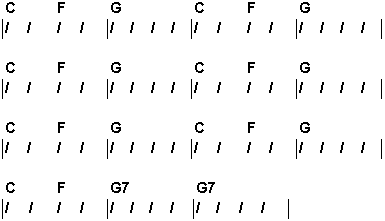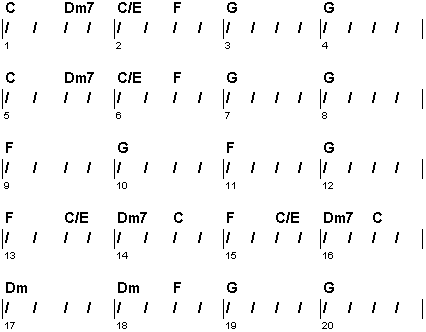
Chord Patterns: Phrases and Repetition
by Conrad Albrecht
So, you've played with ChordSong
and created some short chord sequences, as in our article
Create a Chord Progression: First
Steps.
Now, how do you expand a short chord sequence into a whole song?
One thing most songs' chords have is phrase structure. That's the
way a few chords are strung together to make a short phrase, and then short
phrases are combined into longer phrases.
Chord phrases also repeat a lot, in interesting ways.
Let's walk through one way (out of millions) to build up a song from
small phrases. You'll practice using several phrase structure ideas. Then you
can use these ideas again later when you compose on your own. (The ideas I'll
show are from an actual hit song; I'll reveal its name at the end.)
A song is typically divided into sections (each section is about 8-24
measures long), such as:
-
Introduction
-
Verse 1
-
Chorus 1
-
Verse 2
-
Chorus 2
-
Bridge
-
etc.
We'll create just the chords for one verse and chorus:
When you compose on your own, you might want to start adding melody along the
way; but for now, so we can concentrate on just one thing, we'll just work on
the chords.
We'll create our verse and chorus in 7 steps. You might want to take more than
one session to work through them all:
-
The Basic Chorus
-
Embellish the End of the Chorus
-
Start the Verse (Measures 1-4)
-
Verse Measures 5-8
-
Verse Measures 9-12
-
Verse Measures 13-16
-
Verse Measures 17-20
Step 1: The Basic Chorus
We'll start with the chorus. Often the chorus is the first part of a song to be
created.
First, create a 2-measure chord phrase. For example, I'll use this phrase
from the "mystery hit song":

You can create your own 2-measure phrase (or just copy this one).
Next: Repeat your 2-measure phrase over and over, like this:
 etc.
etc.
How many times should you repeat the phrase? Well, you can play the
phrase 8 times, to make a "typical" 16-measure chorus. But in this case, our
"mystery writer" seems to have just played the phrase over and over while he
sang and made up words, until he decided the chorus was "done". So he ended up
playing the phrase 7 times, most of the time. But sometimes he changes some of
the words and ends up playing the phrase fewer times! So don't worry too much
about it.
If you don't want to make up your chorus's melody and lyrics yet, you can just
play the phrase 4 times or 8 times for now. You can always change it later.
Step 2: Embellish the End of the Chorus
The chorus you have so far is fine, but now let's use another idea from the
mystery song. For the last repeat of the 2-measure phrase, as it leads
into the next verse, embellish it to give it extra interest. This is an
example of variation: repeating something, but changing it.
The mystery song does two things to embellish this last phrase:
-
It adds a "7th" to the last chord;
-
It stretches the last chord from 1 measure to 2 measures.
So, the last phrase of the chorus is changed from:

to:

You can make either of these same changes to the last phrase of your
chorus; but if you can think of your own different way to embellish the phrase,
great!
Here's the whole chorus from the mystery song, with repeats and the final
variation:

Step 3: Start the Verse (Measures 1-4)
Now let's create the verse. The verse comes before the chorus, so
in ChordSong, move the blinking cursor to the beginning of the song and create a
blank line by hitting Enter.
Let's start the verse with a 4-measure phrase. You could create a brand
new, unrelated verse phrase; but instead, let's create the 4-measure phrase by
expanding your 2-measure chorus phrase (another example of
variation).
Here are two ideas (from the mystery song, of course!) which you can use to
expand the phrase:
-
Insert new chords between existing chords;
-
Stretch chords to make them last longer.
The mystery song inserts 2 new chords between the C and F; and it stretches the
G chord to 2 measures. So, the 2-measure chorus phrase:

becomes this 4-measure verse phrase:

Now create your own 4-measure verse phrase by expanding your
chorus phrase. You can insert new chords, stretch chords longer, or invent your
own ways to expand the phrase to 4 measures.
Step 4: Verse Measures 5-8
So, you just created verse measures 1-4. Now, for measures 5-8, just repeat
that 4-measure phrase. So, for the mystery song, verse measures 1-8 look
like this:

Step 5: Verse Measures 9-12
Now, at verse measure 9, let's do something new. You'll create a new 2-measure
phrase. But, create this new phrase from a fragment of your
2-measure chorus phrase.
For example: the mystery song's chorus phrase goes "C F G". And the mystery song
creates a 2-measure phrase here at verse measure 9 from just the "F G" part of
that "C F G" phrase, like this:

So, you do the same thing; create a 2-measure phrase from a fragment of
your chorus phrase.
Then, repeat your new 2-measure phrase. This gives you your verse
measures 9-12. In the mystery song, this is:

Step 6: Verse Measures 13-16
At measure 13 we'll do something similar; create a new 2-measure phrase.
But this time, create it by selecting some chords from your verse measures
1-4, and change the chord order. For example, this was the mystery
song's verse measures 1-4:

The mystery song takes the 1st 4 chords (C Dm7 C/E F) and plays them
backwards, creating this new 2-measure phrase:

Now it's your turn; at your verse measure 13, create a 2-measure phrase by
selecting some chords from your verse measures 1-4 and changing the order.
Then, repeat your new 2-measure phrase. This gives you your verse
measures 13-16. In the mystery song, this is:

Step 7: Verse Measures 17-20
Finally, we're at the last 4 measures of the verse! For these 4 measures,
create a variation of your verse measures 1-4. For example, the
mystery song takes its 4-measure verse phrase:

and replaces the 1st 3 chords with just Dm, which becomes:

Now it's your turn; create your verse measures 17-20 by copying your
verse measures 1-4 and then changing some of the chords.
Putting it all together, here's the whole verse from the mystery song:

And, the mystery song is... "Like A Rolling Stone" by Bob Dylan! I wanted
to use a "real hit song" for our example, and this song is #1 in Rolling Stone
Magazine's "The 500 Greatest Songs of All Time".
What Next?
Here are the phrase structure and repetition ideas we used in this article:
-
Make a chorus by making up a (2-measure) chord phrase and repeating it over
and over.
-
After repeating a phrase several times, apply a variation to the last
repetition (for example, altering the last chord, or stretching it out).
-
Start your verse by taking a 2-measure phrase from your chorus, and
expanding it (by inserting extra chords or stretching chords out) to make a
4-measure phrase.
-
Create your verse's 1st 8-measure phrase by playing a 4-measure phrase
twice.
-
Create a 2-measure phrase in your verse by taking part of another phrase in
your song and changing it (lengthening chords, changing the order of
chords).
-
Create a 4-measure phrase in your verse by playing a 2-measure phrase twice.
-
Create a 4-measure phrase by changing something from another 4-measure
phrase.
Find more songs and study them. Look for how phrases and repetition are
used. You'll learn more ideas, which will help you not feel like you're copying
"Like A Rolling Stone" when you write your own music.
When you're writing your own music, and you get stuck wondering what to
do next, look over the ideas you've collected. You may want to use one of them
"as is", or one of them may give you a creative spark to do something different
and new!
-
-
-
© 2004-2016 Conrad Albrecht. All rights reserved.

 etc.
etc.











